
Fire detectors have to detect fires at an early stage with a high degree of reliability. In a non-fire situation they must not give an improper alarm message. The area of application for fire detectors is absolutely diverse, ranging from clean office space to warehouses and tough industrial settings with the corresponding air pollution caused by eg, production processes.
As a rule, the measuring criterion for detecting a fire is the measurement of the smoke generated by the fire. One simply assumes that if there is no fire, the aerosol density reached through ambient influences will not correspond to the one existing in case of fire. In practice, however, depending on the deployment range of the sensors and the type of combustible material, there is a wide spectrum of types of fire ranging from slowly progressing smouldering fires to rapidly spreading burning liquids which all differ in smoke density, smoke colouring and show very different time curves. The optimal detector should be functioning with the same efficiency under all these different conditions. It is quite obvious, that optical smoke detectors due to their mode of action react with better results with certain types of smoke. This is taken into account by the international test standards for smoke detectors, which request the testing of detectors with various kinds of fires in order to guarantee that a certified detector will provide a certain limit of detection sensitivity.
The use of fire detectors is limited whenever certain physical criteria are present in the environment, which show a great similarity to the physical criteria of a fire. These are to a smoke detector fine dusts, vapour or aerosols that are transported by different means through the air into the measuring chambers of the smoke detector where they produce a signal similar to a fire. Such noise signals, which are very similar to smoke, are for this reason called deceptive signals, because they fake a fire signal for the detector.
Evaluation of false alarm incidence
Fire detectors are nowadays used in the millionth in the most different applications where, in an unobtrusive and reliable way, they serve the purpose of fire protection. Owing to the large number of detectors it does occasionally happen in a critical environment that a deceptive signal of a certain value is produced which corresponds to that of a fire. The probability of its occurring is relatively low, however, the probability of a real fire is also relatively low. In both cases, the alarm being triggered due to a real fire as well as an alarm given due to a deceptive signal, the result is the sounding of such an alarm, which consequently leads to a rescue action. The attention of the user of the fire detector and the fire fighters is thus first of all given to the alarm. Thus the incidence of nuisance alarms, despite their absolutely low rate in relation to the number of fire detectors installed, becomes an important parameter for the functioning of a fire detector.
This parameter can be effectively demonstrated through statistics and frequency or probability distributions. Figure 1 shows schematically the frequency distribution for disturbance signals as well as that for fire detection.
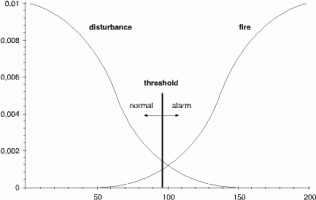
The detector triggers an alarm once the signal level has exceeded a certain value. The minimum setting for such a threshold value is for the detector to identify the test fires according to the applicable standards. Based on the statistical nature of deceptive signals, a residual probability remains with such a threshold value that a deceptive signal may cause an alarm. The shape of the curve in this chart is only shown as schematic progress, in reality, the curve for noise drops much more steeply. However, due to the nature of statistics, an overlapping of the two curves in the vicinity of the threshold remains. The false alarm probability may be influenced by various measures. One non-technical measure would be to drastically limit the number of detectors in critical environments and to take recourse to other means of fire detection, which may be either less effective or more expensive, and less error prone in a critical environment. A technical measure, on the other hand would, eg, be a greater sophistication in signal processing, which already has been developed to a very progressive stage. It would also be possible to evaluate the time curve of the fire, thus being able to differentiate between noise signals, which are either very fast or very slow. In this respect, however, one must keep in mind that one would also have to differentiate between slowly progressing smouldering fires and rapidly growing fires. The result remains that a residual probability of false parameters due to the same physical behaviour cannot be completely excluded and that major improvements in the false alarm behaviour of single-sensor detectors with the means employed cannot be expected. This may well be explained by way of example of a discotheque, where disco fog machines mist over the dance floor every night and nobody would seriously consider deploying detectors with this mode of action.
Observations on a solution with a multisensor detector
In order to find a solution to the problem one has to consider the occurring characteristic parameters of a fire.
In a fire, the most different combustion products are generated:
* Smoke (depending on the material, aerosols of differing density and size).
* Heat.
* Temperature radiation.
* Fire gases.
Smoke detection, as a characteristic parameter for a fire is nowadays the most frequently used method for fire detection. For a large range of surveillance situations, it is almost universally applicable.
Heat and the temperature curve generated in a fire may also be used for fire detection; however, it is quite obvious that the temperature increase in relation to the ambient temperature must be significant for the purpose of fire detection. The temperature sensor must be sufficiently close to the source of the fire for detection, thus the surveillance area is correspondingly smaller in comparison to smoke detectors. For example, smouldering fires generate relatively little heat in the early phase, which sets a certain limit to the scope of application of temperature sensors.
Measuring the temperature radiation is meaningful under the condition that the radiation sensor used has a totally unobstructed field of vision of the potential source of fire. Radiation or optical detectors are equipped with sophisticated technology and due to the unlimited vision field required are merely employed for specific purposes.
During combustion, flue gases are formed as a result of the material transformation. The amount and type of gases formed essentially depends on the material burned and the type of fire. In a smouldering fire, there is a greater volume of carbon monoxide produced whilst in open fires the amount of carbon dioxide will be greater. Additionally, nitrogen oxides will be formed in smaller amounts and also hydrocarbons.
Gas sensors are today available at reasonable cost and with sufficient reliability, service life and low energy consumption. The detection of gases in early fire detection is an important step to further reduce false alarms, thus extending the scope of application.
When taking a closer look at the frequency of gas induced signals under operating conditions, it becomes very clear that the probability of their occurrence is significantly higher than that of a fire. Thus the CO concentration in a room full of heavy smokers will easily come up to values that are also applicable for test fires. In other areas of application this is true as well, high CO concentrations will also be found in automotive workshops, for example, as well as in garages or in workshops with occasional welding.
When looking at the CO concentrations generated in various test fires, it is also noticeable that these concentrations very much depend on the type of fire. Smouldering fires show a marked concentration whilst open fires will show CO values, which may as well also be produced for quite other reasons in a critical environment.
This admittedly generalised assessment of CO for general operations and in case of a fire make one thing clear, however, that the use of a single gas sensor for early fire detection is hardly suitable with the exception that the area to be monitored is strictly limited and it is also quite sure that CO will only be generated in a fire and, should such a fire occur, CO will certainly be generated due to the material burned.
Similar considerations are also applicable for other gases generated in case of a fire.
Does the signal evaluation of gas sensors in a fire detector yield an additional benefit? In order to answer this question concerning their useful deployment, it is necessary to give a balanced assessment of all signals provided by the sensors of a combined detector. It is important that the various sensor signals will show a different behaviour in case of a false alarm in order to get additional information through signal analysis. Thus in case of a dust cloud, it can be safely assumed to get a noise signal from the optical smoke sensor, however, the CO sensor will stay mute while in another case a noise signal from the CO sensor must not necessarily show a disturbance signal for the optical smoke sensor. In the following, we will look at and describe more closely a fire detector with three sensors of different physical modes of action:
* An optical scatter light sensor with a documented sufficient sensitivity to detect fires fail proof.
* A heat sensor with documented insensitivity to smoke, dirt, steam etc. and which reacts to fire only as of a certain heat level.
* A CO sensor with documented CO gas detection as is generated in a fire but with known reaction to false signals to CO in critical environments.
First, it has to be examined whether the signal triplet as it occurs in fires will be distinctly different from the ones in critical environments. These measurements as a rule yield a large number of measured values, which, furthermore, will fluctuate from one measuring to the other. In order to make these rather abstract figures more understandable and presentable, the signal levels are categorised for charting into sectors and classes as is the case on rule based systems (fuzzy logic). It is then possible to arrange the values of all tests easily understandable in a matrix. The chosen classification is as follows:
* 'Nothing' - no measurable signal which could be linked to the event to be measured.
* 'Some' - a signal that can be linked to the event but which is too small in order to make a clear decision on the event (fire, false alarm).
* 'More' - a signal that is close to the threshold value for a single sensor detector but does not fully meet this value. If such a signal is produced by noise, a single sensor detector would be extremely likely to give a false alarm.
* 'Much' - a signal exceeding the threshold value.
* 'Very much' - a signal that clearly exceeds the threshold value.
Sensor triplets of test fires and for a number of noise parameters have been entered into a table on the basis of this definition. Every single sensor principle can now be evaluated in the table. A single optical smoke sensor is potentially prone to give false alarms in case of practically all the noise parameters listed. The recommended use for smoke sensors takes this into account and cautions against their deployment under these conditions. It is furthermore evident that a single optical smoke sensor will not detect the two test fires TF1 and TF6, something which is also not required by the standards. When looking at the paired values of a combined optical and heat sensor it is noticeable that in all fires with 'much' smoke there is also 'some' heat, and where there is 'nothing' with respect to temperature there is 'very much' smoke. The combination with an additional heat sensor renders an improvement in the incidence of false alarms with noise parameters that fake 'some' smoke. The evaluation of signals from a combination of gas sensor and smoke and temperature sensor recommends the use of such a detector in an environment which will, in all probability, not have any CO emission but pronounced deceptive signals in the optical range, such as disco fog.
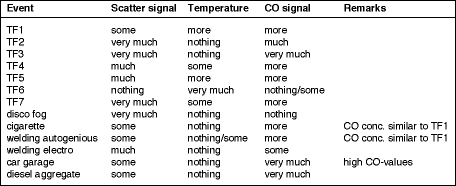
In order to show the difference between a true and a false signal as read by an OTC detector, the values have been once more plotted in a three-dimensional diagram (Figure 2). The small black dots represent the distribution of various noise parameters, while the large red dots indicate the value triplet for the test fires. Only the graphic presentation of the combination of all three physically different signals in a space truly demonstrates the actual distance to the existing noise signals.
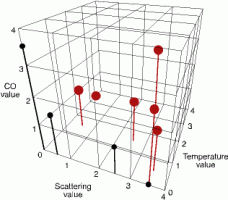
One should now enter into this chart the imagined threshold of an optical smoke sensor. In this three-dimensional chart, this will lead to the creation of an area stretching through the corresponding O value. One recognises that TF1 and TF6 are below the threshold and that certain noise sources are above the threshold (Figure. 3).
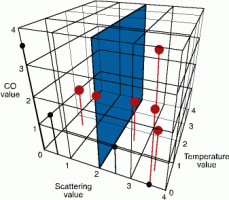
When applying the orthogonal approach made accessible through the use of the three different sensor principles, it is possible to imagine a threshold positioned like an undulated surface between the black and red dots, which allows a much better differentiation between noise signal and real alarm.
The previous observations were merely concerned with the static position of the signals within a three-dimensional space, the timely behaviour of the signals in case of a fire in relation to signals arising from noise sources has not been considered. The evaluation along the time axis permits a far superior assessment of the overall performance of the detector. Signal processing by Magic.Sens OTC410 takes both aspects into account. The decisions reached by OTC410 are founded in a rule-based approach, which simultaneously evaluates the spatial distribution of the signals as well as their dynamic behaviour.
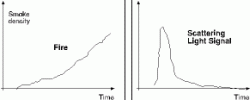
The following criteria are considered before deciding to trigger an alarm:
* Does the signal rise rapidly?
* Does the signal remain constant or does it fade?
* Does the temperature increase?
* Does the CO concentration increase?
In order to understand the dynamic behaviour, we will be looking only at the optical signal. In the actual realisation, the dynamic behaviour of all three sensor components is taken into account.
In case of a fire, it is assumed that the signal rises continuously, whilst the false signal rises rapidly and, after a certain amount of time, fades again.
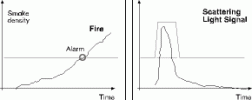
By assessing the time course, it is possible to adjust the alarm threshold to the increment rate of the signal. If the increment rate is typical for a fire, the position of the threshold remains unaltered and the detector will trigger an alarm. In case of a rapid increment, it is concluded to be a disturbance parameter and the threshold will be momentarily raised. Rapid signal increments are taken to be a potential noise and the optical threshold is being shifted to a less sensitive range.
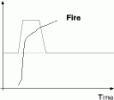
Before deciding whether exceeding the optical threshold truly constitutes an alarm event, it is first checked if the signal size remains constant and thus presents a real alarm. This allows for the reliable detection of a fire due to a signal increase, which was first considered to be caused by a noise parameter.
The extension of the principal approach laid out in this paper to more complex signal curves and to the combination of the signal triplet of the three sensors permits an intelligent adaptation of the threshold to the currently existing environmental conditions.
The absolute order of magnitude of the false alarm rate can only be determined by recording differentiated statistics. There are attempts made by various fire brigades and higher institutions to establish such values. The result, however, very much depends on the fact whether it is known how many detectors are deployed in the field, what type of sensors are used and what brand they are. Also of importance is to know the kind of environment in which they are installed and whether the false alarm is due to the sensor or the system. In order to reach precise values, it is always necessary to use a differentiated approach. Based on the statistical relation between false alarm incidence and position of the decision threshold and integrated dynamic adaptation it is safe to say that a combined detector as described above clearly promises a lower false alarm rate than the traditional detector method.
Summary
The use of several different characteristic parameters clearly provides a much better differentiation between false signals (noise) and fires. The combination of signal processing methods which take the typical time curve of influence parameters and true fires into account furthermore permits a successful suppression of any false signals similar to fires.
For more information contact Shane Nefdt, Bosch Security Systems, 011 651 7810, www.boschsecurity.com
| Tel: | +27 11 651 9600 |
| Email: | [email protected] |
| www: | www.boschsecurity.com/xf/en |
| Articles: | More information and articles about Bosch Building Technologies |

© Technews Publishing (Pty) Ltd. | All Rights Reserved.